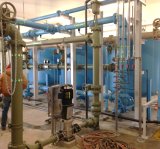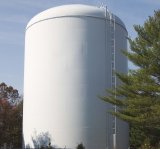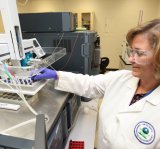Drinking Water Research
Drinking water systems face increasingly greater challenges for delivering adequate supplies of drinking water. EPA’s 6th Drinking Water Infrastructure Needs Survey and Assessment (2018) indicates that $472.6 billion is needed over the next 20 years to maintain and improve drinking water infrastructure in the United States. Research into innovative, cost-effective approaches is needed to optimize the efficacy and efficiency of water treatment and distribution for these systems.
EPA’s Office of Research and Development provides critical information from research activities to inform Agency regulatory actions and guidance, implementation actions at the region and state levels, management of water systems by local municipalities, and technical assistance to communities. Emphasis is being placed on providing actionable and affordable solutions for small systems (systems serving 10,000 or fewer people) in underserved rural and urban communities, which often face greater technical, financial, and operational challenges to comply with drinking water standards.

Treatment and Control of Contaminants
Learn about how our drinking water treatment and control of contaminants research is developing and evaluating effective and low-cost treatment technologies for small water systems and overburdened communities and is advancing innovative and sustainable technologies and processes for addressing contaminants, such as PFAS, lead, algal toxins, disinfection byproducts, and opportunistic pathogens.

Infrastructure Resilience and Sustainability
Learn about how our drinking water infrastructure resilience and sustainability research is addressing approaches for maintaining water quality and improving the reliability and security of distribution systems with a focus on approaches that are affordable and practical for small and/or overburdened communities.

Source Water Quality
Learn about our source water quality research to advance monitoring and mitigation of source water pollutants, including those associated with wildfire and harmful algal blooms.

Exposure and Health Risks
Learn about our drinking water contaminants exposure and health risks research and how EPA researchers are characterizing potential exposure pathways and consequences of contaminants in drinking water systems, including premise plumbing, to inform current and future health-based decisions.

Models, Tools, and Analytical Methods
Access our drinking water models, tools, and analytical methods developed and evaluated by EPA researchers and partners, including those for treatment, contaminants, distribution systems, cost, security, resilience, and source and treated waters.

Technical Assistance in Support of BIL
Learn about how EPA researchers are providing small and/or disadvantaged communities with drinking water technical assistance in support of the Bipartisan Infrastructure Law (BIL) to identify lead service lines for inventories and replacement and to assist with cost-effective treatment options for emerging contaminants, including PFAS.

Training, Outreach, and Technical Support
Learn how the training, outreach, and technical support provided by EPA’s Office of Research and Development applies research results, models, tools, and expertise to build help in building drinking water system capacity and sustainability and helps communities with critical needs.
